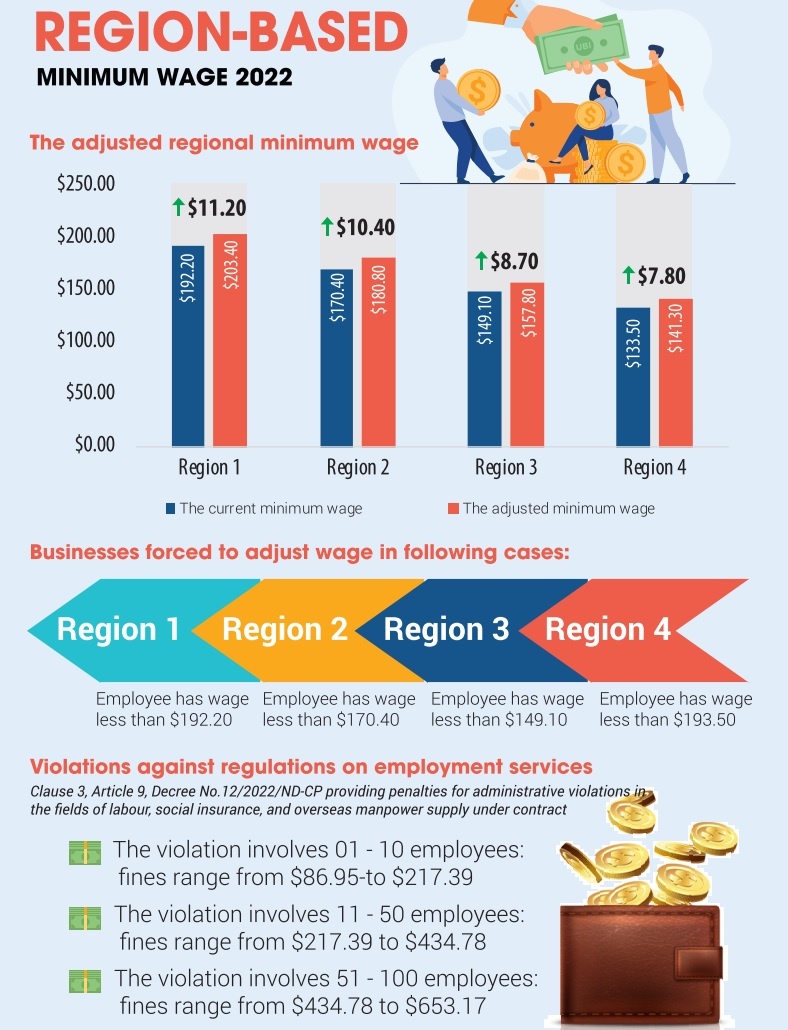Employers seek time for pay-rise change
Eight associations last week sent a letter to the National Assembly’s Committee for Social Affairs and a number of ministries, asking them to apply the proposed pay rise policy in January 2023, instead of July this year, so that employers can prepare for it properly. Some of the associations include the Japanese Chamber of Commerce & Industry (JCCI), the Vietnam Association of Seafood Exporters and Producers, the Vietnam Textile and Apparel Association, the Vietnam Timber and Forest Product Association, and the Vietnam Plastic Association.
 |
On April 12, the National Wage Council (NWC) decided on a 6 per cent climb in minimum wages for those working at privately-owned enterprises in Vietnam. The scheme, typically implemented under a fixed annual roadmap, has been submitted to the government for consideration and adoption. The council proposed that the pay rise enter into force on July 1 and last until the end of 2023.
However, employers via their associations stated that they cannot change their business strategies and production plans before July, as their strategies involving production, business, finance, and orders have already been fixed from the end of last year without taking into account any pay rise.
“All enterprises have already implemented wage increases in early 2021 and 2022. At the same time, contracts with partners have been signed since the beginning of the year and so we cannot increase the selling price of goods,” the letter said. “Increasing wages in the middle of the year will push businesses into a very difficult situation, and many may have to cancel contracts because of uncertain costs.”
These associations also noted that a July 1 change could lead to cutting labour, suspending or reducing production, or even going bankrupt, which would potentially put tens of thousands of workers at risk.
Koji Ito, chairman of the JCCI, acknowledged that the wage rise is necessary. However, he said that the future of Vietnam’s garments, textiles, footwear, and manufacturing and processing sectors will be impacted in terms of labour costs. Over 75 per cent of Japanese enterprises in Vietnam agreed that wage increases will impact their business, according to Ito.
Unlike the previous pay rise, the proposal to increase the regional minimum wages would take place in the middle of the year, which has received additional mixed opinions.
“Any application from July 1 is unprecedented. Normally the adjustment period will start on January 1 of each year,” noted Deputy Minister of Labour, Invalids, and Social Affairs Le Van Thanh, who is also chairman of the NWC.
However, Thanh noted that the typically-annually regional minimum wage has not been adjusted for the past 18 months due to the pandemic, and the proposed application period was considered to create stability for employees and business plans.
Organisations and analysts believe the pay rise would be important. Economist Le Duy Binh, managing director of consultancy firm Economica Vietnam, analysed that the cost of food accounts for about 48 per cent of a family’s total expenditure, which can rise to as much as 60 per cent for unskilled workers. The median wage of all workers has remained relatively unchanged during the past two years, while the price of essential items has continuously increased by 10-50 per cent.
Binh explained that many enterprises already pay wages higher than the minimum, so only those that are paying the minimum wage will be greatly affected, especially those operating in labour-intensive industries such as textiles, footwear, and agro-forestry-fishery processing.
“Business performance depends a lot on the quality of human resources and their productivity, and labour productivity in 2022 is expected to increase by 4.71 per cent,” Binh said. “Increasing incomes for employees when productivity increases are both the responsibility of employers to ensure fairness, and a way for them to protect and nurture important resources for production and business.”
The NWC said the 6 per cent figure was based on calculations by the technical department and the agreement of the parties involved. With an expected consumer price index increase in 2022 of about 4 per cent, the current regional minimum wage is still 1.3 per cent lower than the minimum living standard in 2022 and about 5.3 per cent lower than the minimum living standard in 2023.
This increase is equivalent to a rise of $7.85-11.35, and the minimum living standard of workers will be improved by 0.78 per cent by 2023. Previously, the regional minimum wage in 2019 increased by 5.3 per cent compared to 2018 and in 2020 climbed by 5.5 per cent compared to 2019.
What the stars mean:
★ Poor ★ ★ Promising ★★★ Good ★★★★ Very good ★★★★★ Exceptional
Related Contents
Latest News
More News
- Global partnerships key to Vietnam’s IFC development (December 26, 2025 | 16:18)
- Vingroup pulls out of bid to invest in North-South high-speed railway (December 26, 2025 | 11:42)
- Strengthening supply chains through trade promotions and customs reform (December 24, 2025 | 14:00)
- PM orders investment model for North–South high-speed rail (December 22, 2025 | 17:43)
- LS Eco Energy to invest in Vietnam rare earth sector (December 22, 2025 | 17:31)
- Government moves to establish International Financial Centre (December 21, 2025 | 21:00)
- Vietnam's IFC to target global investment flows (December 21, 2025 | 18:00)
- Two national hospitals expand capacity with new facilities (December 20, 2025 | 09:00)
- Ha Tinh breaks ground on major Vingroup industrial and energy projects (December 19, 2025 | 18:24)
- EVN launches major power infrastructure projects nationwide (December 19, 2025 | 18:17)

 Tag:
Tag:





















 Mobile Version
Mobile Version